- Why conversion rates are so hard to boost
- The challenge of scaling post-click landing pages
- Collaborating to scale post-click landing page production
- How to scale post-click landing pages with your team
- The Instapage Collaboration Solution
- Instablocks™
- Global Blocks
- Scale your post-click landing page production better today
Building a great post-click landing page is hard to do. There’s no disputing it. Average conversion rates, according to one study, fall somewhere between 2 and 5%.
That’s 2 to 5 out of every hundred people converting on your offer. Today there’s still, clearly, a gap between the ad and post-click landing page that needs closing.
But as businesses attempt to address this problem, they’re confronted with several new ones:
Why conversion rates are so hard to boost
If you’ve spent any time on the Instapage blog, you know a lot goes into publishing a post-click landing page. It’s not like designing any other page.
Other pages — like the blog, “About” page, pricing page, etc. are primarily informational. post-click landing pages, on the other hand, aren’t.
post-click landing pages are designed for one specific goal: conversion. And converting visitors is a lot tougher than simply informing them.
It requires moving them to action. And that takes a careful assembly of persuasive elements, which include, but aren’t limited to:
- Message matched headline
- Valuable media
- Benefit oriented copy
- 1:1 Conversion ratio
- Trust indicators
- Compelling CTA
Arranging these elements successfully requires a knowledge of your visitor: motivation, obstacles to conversion, design best practices, and on-page friction. Those discoveries often come through a long look at data both internal and external, qualitative and quantitative. You’re running surveys, sifting through analytics, and cross-referencing with industry research.
And even if you do all this, you still won’t build it perfectly on the first try.
It’s only after successive attempts at post-click optimization that conversion rates begin to rise. But, many don’t even get this far.
The challenge of scaling post-click landing pages
Many marketers are still stuck in a world where the ad is the focus of the campaign. And that’s not to say it shouldn’t be a focus, but it certainly shouldn’t be THE focus.
No matter how personalized a promotion is — whether you’re using a Meta Pixel or LinkedIn Matched Audiences, Google Ads or your own email list — it won’t perform optimally without a personalized post-click landing page to match it.
Creating this connection between the ad and post-click landing page is known as message match. By matching headlines, colors, images, logos, and keywords between the ad and post-click landing page, you boost trust in the mind of the visitor. When they click through, they land on a recognizable page. Your branding is there, the images they saw in the ad are there, and so are specific keywords. They feel free to evaluate the page.
So, when you consider all this, it becomes easy to see why scaling post-click landing page creation is so difficult. If every page has to be as personalized as its referring ad, you now have to create as many post-click landing pages as you do ads.
And, while ad creation can be delegated to one employee, manual creation of so many post-click landing pages cannot.
Collaborating to scale post-click landing page production
Most advertising software comes complete with tools for scaling. You can easily duplicate ads, adjust them from a single dashboard, and push them out en masse if need be — each to different audiences if you choose.
But, building a post-click landing page for most remains a challenge, for a few reasons.
1. Marketers are busier than ever. Today’s advertising isn’t that of the newspaper era, nor the TV era, where campaigns were meticulously built and run for months at a time. Now, it’s not uncommon for businesses, big and small, to run several campaigns at once, for as short a span as a few hours. Such fast-paced advertising requires constant focus, lest your budget be eaten by a low-performing ad. When designers, analysts, managers, and copywriters are constantly neck-deep in pre-click content, it leaves little time to scale post-click landing page production.
2. There’s still a shortage of powerful post-click landing page tools. Over the last several years, marketing tech has been slowly catching up to the needs of advertisers. Still, though, ad tools outnumber post-click landing page tools by a great margin.
3. Employees are becoming increasingly remote. Over 60% of businesses report hiring remote employees. From a skill perspective, this is great. Both agencies and in-house teams can select from a greater pool of talent. However, from a collaboration perspective, it can be a nightmare.
Managing remote teams is not easy. Where a group of in-house creatives can meet in a conference room and run through a wireframe, fold by fold, a remote team cannot. Many times, even with project management software and communication tools, this results in a scattered attempt at post-click landing page scaling. Files get lost, goals go unmet, and it’s not uncommon for pages to get published before they’re ready.
When faced with such problems, some abandon post-click optimization altogether. But, ones serious about campaign performance take a different route.
How to scale post-click landing pages with the help of a team
Whether your team is in-house or globally remote, scaling post-click landing page production can prove challenging. Long, confusing email chains are common. Screenshots get cluttered with red arrows and comments. Chaos ensues.
Fortunately, there’s a better way.
The Instapage Collaboration Solution
For remote teams, especially, designing a single post-click landing page can take days, a week — sometimes more depending on the workload. There’s wireframing to be done, copywriting, designing logos and images or videos…
Then you have to bring it all together to form a functional, publishable page. The back and forth can seem endless.
When you need everyone on the same page, the Instapage Collaboration Solution is where to start. Here are a few key features:
Hotspots
With hotspots, wave goodbye to cluttered screengrabs. to leave feedback for your team, simply click anywhere to open a comment box. Use an “@” symbol followed by a name to ensure they receive an email notification of your comment. Here’s what an open hotspot looks like:
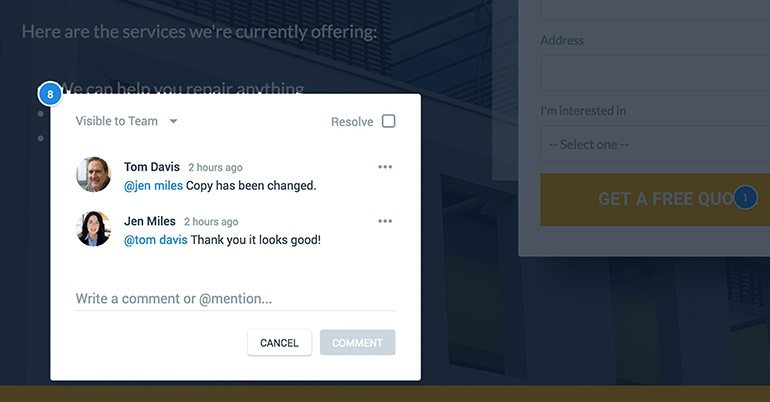
In the upper left, edit permissions to keep key content protected. Then, simply click away to collapse the hotspot. When you do, it will look like this:
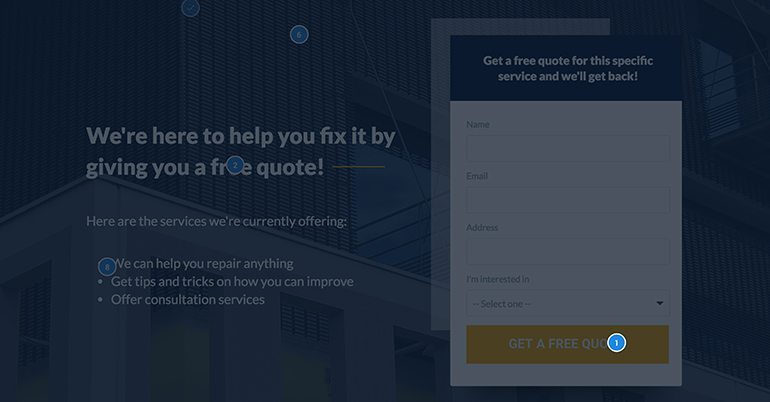
Until you click one of the hotspots to open, the page will remain neat and unencumbered by text comments.
Comment feed
Hotspots de-clutter a page, which is great for collaborators evaluating the design. However, it can be bad for those attempting to answer a specific comment among a large number of hotspots. For those people, the comment feed is a place from which they see all comment threads for all hotspots. There, they can sort through text, and answer easily without hunting through every commented-on element the page features:
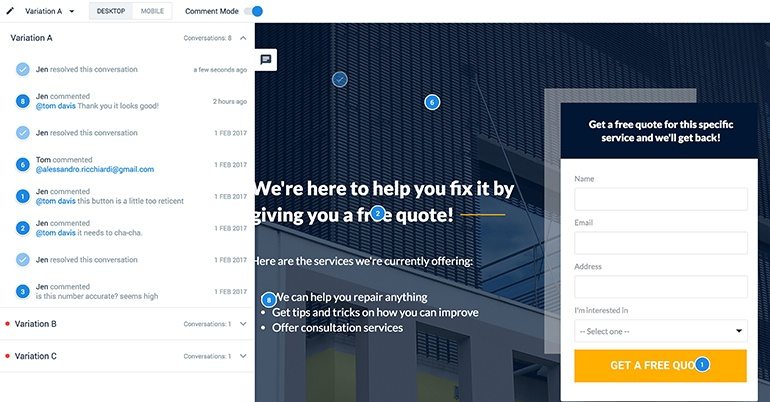
Message center
For an even easier way to sift through comments, the Message Center, accessible from the dashboard, allows a clear view of conversations between collaborators:

With a filter, easily sort by workspace, chronology, or read and unread comments. In the Message Center, no feedback gets lost or forgotten.
Sharing
When it comes to sharing with collaborators, the exchange of sensitive company data, like account passwords, is often necessary. But with the Collaboration Solution, you’ll ensure the safety of such data with a “Share” button, which enables sharing to collaborators via email or password-protected link:
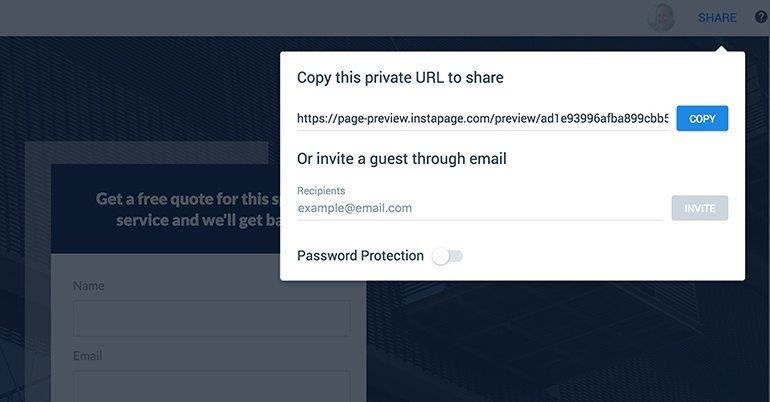
Instablocks™
Even if you’re building from a template, with help from your team, scaling post-click landing page creation can be a hassle.
Say, for example, you had three different Google Ads, each with a unique headline and copy. You want the ad headline and the post-click landing page headline to match, as well as the copy.
It would require you either duplicate your page and update all the content, or start over with a new template, and copy and paste from the old page.
With Instablocks™, though, you can save edited elements and insert them onto any new or duplicated page:
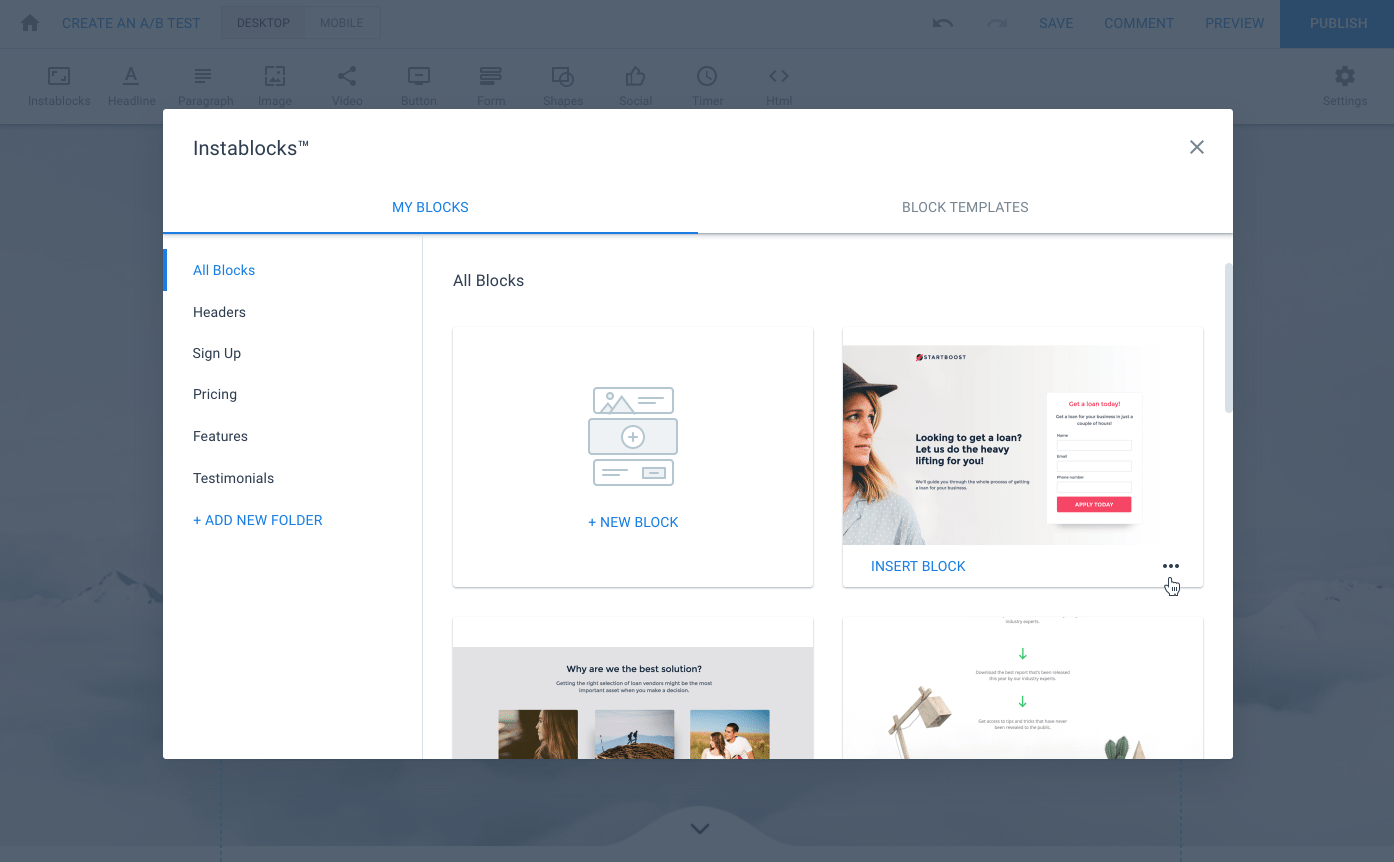
Global Blocks
Instablocks edits page to page easier, but what if you need to edit groups of pages? What if you’re cleaning up some outdated copy, or replacing an and old video throughout your campaigns?
For that, there’s Global Blocks. With this feature, forget manually clicking to edit text, uploading new videos, or replacing old content page by page. Simply insert any edited element to groups of pages from one convenient location.
With Global Blocks, you can inject the winning video from your multivariate tests to all pages. You can update an old logo. You edit new keywords into your copy from a central dashboard. This tool makes any major campaign issue an easy fix.
Start scaling your post-click landing page creation with a team
Scaling post-click landing page creation is easier with a team, but only if they have the right set of tools.
With the Instapage Collaboration Solution, Instablocks, and Global Blocks, you can bridge the personalization gap faster than ever before. See how well your team scales post-click landing page production, sign up for an Enterprise demo today.

See the Instapage Enterprise Plan in Action.
Demo includes AdMap™, Personalization, AMP,
Global Blocks, heatmaps & more.
